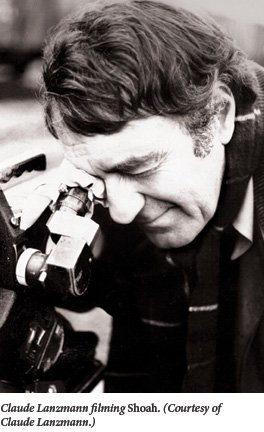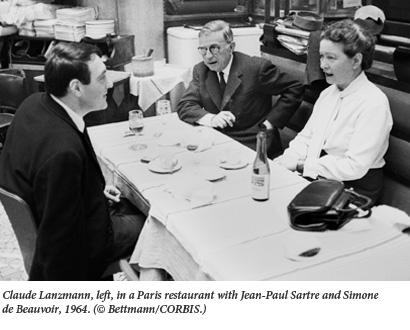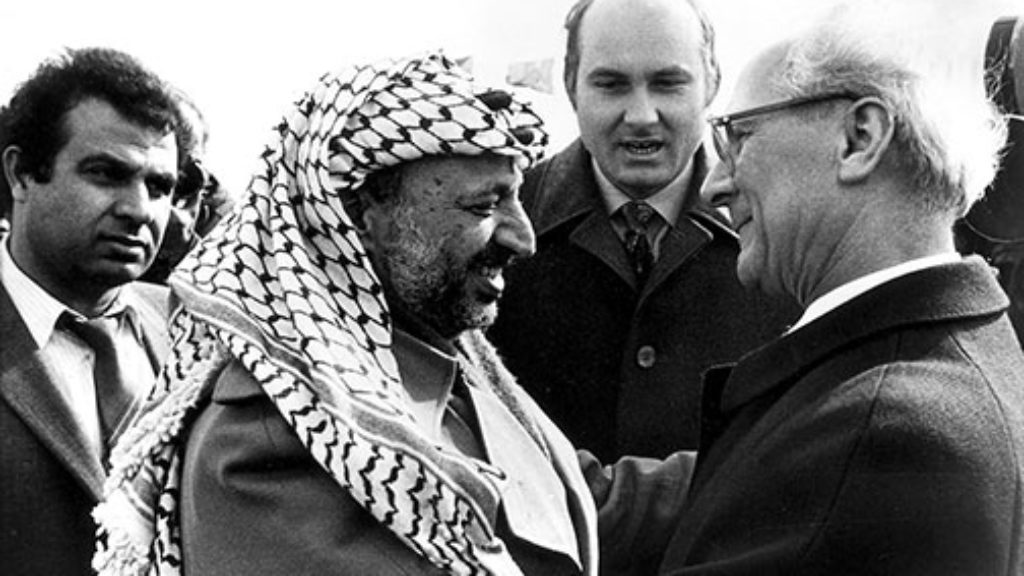Chasing Death
“I have been told a thousand times by a thousand different people that I ought to write the story of my life, that it was rich, multifaceted, and unique, and it deserved to be told. I agreed.” Already in the foreword to his memoir The Patagonian Hare, Claude Lanzmann gives a good sense of the kind of man he is and the kind of book he means to write. To put it briefly, he is without modesty, either false or otherwise; he writes with frank admiration about himself and his accomplishments as a journalist, adventurer, sportsman, and lover, and above all as the director of the landmark Holocaust documentary Shoah. Yet this admiration is so undisguised that Lanzmann seems, paradoxically, to be without vanity. He simply enjoys the spectacle of his life so much that he expects his enthusiasm to be infectious. And it is: The Patagonian Hare is a wonderfully entertaining book. “You must understand that I love life madly, love it all the more now that I am close to leaving it,” writes the 86-year-old Lanzmann, and if ever there was a life worth loving and reading about, it must be the one chronicled in these pages.
 This is not to say that Lanzmann’s existence has been carefree. As a French Jew born in 1925, he was destined to live through the Nazi occupation and fight in the Resistance, risking his life again and again before he turned 21. If he seems to have gone through these experiences with equanimity, even a certain bravura, it may be because his earliest childhood was so frightening and chaotic for purely domestic reasons. His father and mother, brought together in an arranged marriage, hated each other with a violent, operatic passion and subjected their oldest child to horrifying scenes. Lanzmann writes of seeing his father lie in wait for his mother with a knife and emptying a gun in her direction. By the time his mother left the family, when he was 9, “My first reaction was relief rather than sadness: my parents’ arguments had grown so frequent and so violent over the years that I lived in fear that the worst would happen, perhaps murder or suicide.”
This is not to say that Lanzmann’s existence has been carefree. As a French Jew born in 1925, he was destined to live through the Nazi occupation and fight in the Resistance, risking his life again and again before he turned 21. If he seems to have gone through these experiences with equanimity, even a certain bravura, it may be because his earliest childhood was so frightening and chaotic for purely domestic reasons. His father and mother, brought together in an arranged marriage, hated each other with a violent, operatic passion and subjected their oldest child to horrifying scenes. Lanzmann writes of seeing his father lie in wait for his mother with a knife and emptying a gun in her direction. By the time his mother left the family, when he was 9, “My first reaction was relief rather than sadness: my parents’ arguments had grown so frequent and so violent over the years that I lived in fear that the worst would happen, perhaps murder or suicide.”
By comparison, it must have been almost restful for the teenaged Lanzmann to spend the years of war and occupation living in Vichy France with his father, brother, and sister. He recalls living fairly openly, attending a school where he was one of several Jewish pupils and even smuggling himself over the border into the Occupied Zone to visit his mother in Paris. On one such journey, Lanzmann writes, his difficult mother took the 16-year-old shoe shopping and kept demanding to see more and more pairs. The young Claude realized what his mother evidently did not—that her “enormous Jewish nose” was attracting the attention of the other shoppers, that her obstreperousness was putting their lives in danger. Terrified, he fled the store without her, a desertion that haunts him to this day. “That afternoon, I behaved like a dyed-in-the-wool anti-Semite of the worst kind: a Jewish anti-Semite.”
It doesn’t take a Freudian to suspect that Lanzmann’s fondness for death-defying feats, a leitmotif of The Patagonian Hare, can be understood as both a return to and atonement for these early traumas. Because the structure of the memoir is not strictly chronological but associative, Lanzmann creates some psychologically fascinating juxtapositions. He has barely begun sketching his childhood, in chapter two, when he shifts into a long, boastful story about the making of Tsahal, his documentary about the Israel Defense Forces. During filming, in the 1990s, he had the chance to ride in a Phantom fighter jet and an F-16. For a man in his sixties, this was no tourist jaunt. There was a real possibility of fainting and vomiting, not to mention more serious accidents. When Lanzmann emerges unscathed from the flights, greeted by “rapturous applause from a crowd of 200 people,” it seems as though he is enacting a trial by fire: he must symbolically risk his life for the Jewish state, just as he spent his youth risking it for being a Jew.
It is remarkable, in fact, how many near-death experiences Lanzmann relates in The Patagonian Hare. The title alludes to a story by the Argentinian writer Silvina Ocampo, quoted in an epigraph, about a hare chased through a forest by dogs: “‘Where are we headed?’ cried the hare in a voice that quavered like a lightning flash. ‘To the end of your life,’ howled the dogs in dogs’ voices.” When he was not being chased by the Gestapo or Milice française (the Vichy regime’s version of the Gestapo), the teenage Lanzmann was risking the wrath of Communist partisans. Though he led a Communist underground group at his lycée, he refused to follow the Party’s orders to steal a cache of weapons hidden by his father, who was part of a conservative Resistance faction. The result was a putative death sentence from the Party, never enforced. No sooner was the war over than Lanzmann, a newly minted college graduate, went to occupied Berlin as a professor-a Jew teaching former Hitler Youth. He writes of going to dinner at the house of a friend, where his fellow guests included a dozen ex-Wehrmacht generals.
And when the world provided no dangers, Lanzmann arranged his own: he was carried off by riptides on a dangerous Israeli beach, got lost in the Swiss Alps on a trek with Simone de Beauvoir, and once crashed through a plate glass window he mistook for an open door. When he writes, in the very first sentence of the book, “The guillotine—more generally, capital punishment and the various methods of meting out death—has been the abiding obsession of my life,” it is all too easy to believe him.
To some people, the thought of death is melancholy and enervating; to others, it is a provocation to seize the day. Lanzmann definitely falls into the second category, and he courted women as eagerly as he courted death. When he fell in love with Simone de Beauvoir, he was in his twenties and she was in her forties, already famous as an existentialist thinker and the author of The Second Sex. She was also, of course, the maîtresse en titre to Jean-Paul Sartre, who welcomed Lanzmann as his successor; things got even cozier when Lanzmann’s younger sister became Sartre’s lover. “Castor,” to use Beauvoir’s nickname, served as Lanzmann’s entree to the world of the French intellectual mandarins. (He even claims to have given her the title Les Mandarins for her famous autobiographical novel.) Later he was married twice, the second time to the actress and author Angelika Schrobsdorff, whom he met in Israel. “In my rough and ready way, I swept her off her feet by the intensity and sincerity of the passion I felt for her from the moment I first set eyes on her,” Lanzmann writes.
It was not the first or last time he would have this effect on a woman. One of the most delightfully over-the-top stories in The Patagonian Hare concerns Lanzmann’s brief, unconsummated affair with a nurse he met in North Korea in the 1950s, when he was traveling as part of a delegation of French leftists. The Iron Curtain was no match for his charisma, and Kim Kum—sun hurled herself at the French visitor even though it meant risking official censure, or worse. Even in his eighties, Lanzmann takes care to mention that he is still potent, though the way he describes his approach with women—”I hate . . . the billing and cooing of courtship . . . these days I head straight, as Husserl might say, for ‘the thing itself'”—sounds somewhere between the unreconstructed and the Strauss-Kahnian.
 To most American readers, however, it will feel rather strange to think about Lanzmann in these terms, since the Lanzmann familiar to us is not the one famous in France. There, he is an intellectual celebrity and the editor of the great journal Les Temps Modernes. Here, his name is wholly associated with Shoah, which came out in 1985 and was immediately recognized as one of the greatest documentary films ever made and a key work in the understanding of the Holocaust. References to the film come up throughout The Patagonian Hare, but it isn’t until the last hundred pages or so that Lanzmann writes in detail about the making of it.
To most American readers, however, it will feel rather strange to think about Lanzmann in these terms, since the Lanzmann familiar to us is not the one famous in France. There, he is an intellectual celebrity and the editor of the great journal Les Temps Modernes. Here, his name is wholly associated with Shoah, which came out in 1985 and was immediately recognized as one of the greatest documentary films ever made and a key work in the understanding of the Holocaust. References to the film come up throughout The Patagonian Hare, but it isn’t until the last hundred pages or so that Lanzmann writes in detail about the making of it.
Anyone who has seen the nine-plus hours of Shoah will remember Lanzmann, even though he is not really a “character” in the film. He appears only as a facilitator, eliciting memories from the survivors, bystanders, and perpetrators who fill the screen. Yet the force of his personality comes through unmistakably, thanks to the tone and nature of those questions and the remarkable, at times brutal, persistence with which he asks them. Interviewing the Treblinka guard Franz Suchomel, for instance, Lanzmann is emollient, even deferential, knowing that this is what it takes to get an SS man to talk about his crimes. Yet Lanzmann the director frames the sequence to show us that Suchomel is being recorded by a hidden camera, whose signal is sent to a recording van parked outside his house. The film shifts back and forth between the black-and-white of the interview and the color film of the van.
By enlisting the audience in his deception, Lanzmann makes clear how distasteful he finds the necessity of buttering up this war criminal. His true feelings break through only in fleeting moments—for instance, when Suchomel sings a work-song that Jews at Treblinka were forced to learn. “We’re laughing about it, but it’s very sad,” Suchomel says, and Lanzmann replies in a steely voice, “No one is laughing.” At such moments, it becomes clear how much moral and spiritual courage it took for Lanzmann to submerge himself, for years and years, in the nightmare he was documenting.
Lanzmann discusses the encounter with Suchomel in his memoir, explaining that he smuggled a then-cutting-edge kind of camera, a Paluche, in his briefcase; Suchomel had agreed to be audiotaped in exchange for money, but he didn’t know he was being filmed as well. At other times, however, this gambit ended in disaster. An attempt to secretly film Heinz Schubert, a veteran of the Einsatzgruppen, went awry when neighbors heard voices coming out of the recording van. A group of angry Germans surrounded Lanzmann and his translator and started to beat them up; “covered in blood,” they fled the “braying pack” and escaped in his car. Even worse, the Paluche was left behind, and the Schuberts brought criminal charges against Lanzmann. It was just one of the many obstacles he had to surmount in the years of filming; indeed, he writes at length about the way making Shoah consumed his life and his savings. Funding for the film was always uncertain, and Lanzmann is still rancorous toward individuals and institutions who failed to help him in his time of need.
Lanzmann’s toughness, in Shoah, takes other forms as well. One of the most famous scenes in the film is his interview with Abraham Bomba, the so-called “Barber of Treblinka,” a Jewish prisoner who was forced to cut women’s hair before they were sent to the gas chamber. Lanzmann chose to interview Bomba cutting hair in a barbershop, though he reveals in The Patagonian Hare that this was a staged setting: The man sitting in the barber chair is a friend of Bomba’s, and while he plies the scissors, he does not actually cut any hair. The familiar environment and distracting task were designed to make it possible for Bomba to talk about Treblinka, and even then he finds one memory too hard to share—the day when a fellow barber saw his wife and child enter the undressing room. At this moment in the film, for the first time, Bomba breaks down and can’t go on, until Lanzmann insists: “You have to do it. We have to do it.”
There is something cruel about this insistence—most of us could not force a Holocaust survivor to return to the worst moment of his life. But for Lanzmann, Shoah was not just a film, it was a historical mission and a life work, and he was willing to do just about anything to get it made. “Abraham’s tears were as precious to me as blood, the seal of truth, its very incarnation,” he writes. “Some people have suggested some sort of sadism on my part in this perilous scene, while on the contrary I consider it to be the epitome of reverence and supportiveness, which is not to tiptoe away in the face of suffering, but to obey the categorical imperative of the search for and the transmission of truth.”
In the end, Lanzmann is convincing: There is an extraordinary tenderness and trust involved in this difficult collaboration between filmmaker and subject. It is a trust built on Lanzmann’s acceptance of the impossibility of his ever truly sharing Bomba’s burden. “I had been absolutely contemporary to the Shoah, I could have been among its victims,” he writes, yet somehow he had “consigned it to a different time, almost to another world, light years away, beyond human time.” This paradoxical alienation is exactly why the film retains its power as time takes us further from the events it describes.
For Shoah is fundamentally about the impossibility of approaching or representing the Holocaust. What Lanzmann’s camera shows, at every moment, is that there is nothing for him to show. The camera is driven at a slow pace down the very route that the gas vans of Chelmno took, from a church to a mass grave in the forest; the road and the church and the forest are still there, but there is no way to show the dead. An engineer peers backward from his locomotive as he runs the train to Sobibor, but the twenty cars full of Jews he once took down this same path are gone. Even a shot of a sign bearing the name Treblinka seems to be marveling at the trivial yet incomprehensible fact that Treblinka exists on the same Earth where you and I live.
Reading The Patagonian Hare, it’s tempting to conclude that only a man as enamored of life as Claude Lanzmann could have managed to make a film so unwavering in its contemplation of death.
Suggested Reading
Scenes of Jewish Life in Imperial Russia
What was life like in pre-revolutionary Russia? It certainly did not take place in an unchanging shtetl.
Thoroughly Modern Maimonides?: A Rejoinder
To sharpen Stern’s point, we may say that the person who believes God literally gets angry metaphorically angers God.

East Meets West
Following the Six-Day War, the East German government and the West German far left demonized Israel time and again, often vilely equating it with the worst thing in their own nation’s history: Nazism.
Are We All Protestants Now?
Leora Batnitzky's new book charts the development of modern Jewish thought.
Comments
You must log in to comment Log In